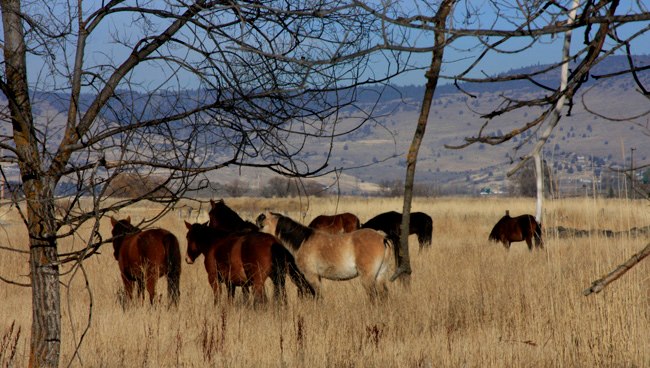Written by John Cox, M.A. C/M
“Wild Horses acquaint us with cultural heritage beyond commercialized human endeavors, and over a long history of doing so. Many of us built our life around The Horse, for this exact purpose, whether acknowledged or not.” — John Cox, Cascade Mountains
We are currently discovering “overlooked information” and over centuries of supposed fact-finding, in the matters of The Horse and Wild Horse historical events. Troubling, is the fact this situation shows a weakness in our ability, to accept facts as, well, simply factual. The Horse is a good case example, of acceptance or mental-denial, via bias or just plain ignorance. Myself and others have seen a tremendous amount of people, accept some things about Horses, and yet deny others, and ironically, have become horse experts within that same 10 minute conversation about horses — yet never been around horses, or owned horses, nor ever seen a wild horse. Yes, things are this bad in The Horse world of today . . .
The Science of Science
Divergence in Biology. The evolution of different forms or structures in related species as they adapt to different environments. An example of divergence is the development of wings in bats from the same bones that form the arm and hand or paw in most other mammals.
We are having a problem with the facts given to us over the years, from known bone piles, and ignored facts — that today’s Horses come from merely one group of horses, the Hyracotherium. As we discover diversity within bone structures as well as the skull, or femurs.
The modern day species of Equus (horses, zebras, and asses) have been around for about 2 million years. They are very different from the earliest known horse, Hyracotherium, otherwise known as Oehippus, or “Dawn Horse”. This ancient horse was a small, dog-sized creature that lived from 55 to 45 million years ago. The root of Divergence into . . .
What animal did horses evolve from? The genus Equus, which includes all extant equines, is believed to have evolved from Dinohippus, via the intermediate form Plesippus. One of the oldest species is Equus simplicidens, described as zebra-like with a donkey-shaped head. The oldest fossil to date is ~3.5 million years old, discovered in Idaho. Area proximity with other bone-piles, tells us other forms of the horse, around the same period, much different, yet Divergence occurred similar — none the less, this find shows Horses to be Indigenous in the America’s (despite the complete fulfillment of today’s horse occurring at that time) from their very beginnings. Which is something overlooked, not just by government, but by many people.
The problem: Many of us think, after perusing tooth structure and jawbone structure from ancient bone-piles, as well as skulls, femurs, hooves, hips, and miscellaneous bone structures, between the Wild Horses, as they age through the centuries, that there was more than one, and very possible up to four prehistoric animals that Divergence took place from . . . Which formed the basis to eventually intersect through the centuries, creating the physical make-up of what we see today, as the Modern Horse. I will elaborate further on this entire subject, and fellow anthropologists, biologists, intermixed with Paleoanthropologists as well as molecular physicists, among other science people. The process of Darwin’s theories of Natural Selection, has placed into this same situation, also, and with amazing results we see today within the physical make-up of the Horse. . .
Need we not forget, the Genetics and alteration of the stature, both physically and mentally, is also a robust industry, with some good results, but there always appears that one or two problematic circumstances, that remain unacceptable. Humans are not good at genetics, but merely sell themselves as knowing what they are doing. This remains yet another problem we see today, in the Modern Horse.
What we have found is the inconsistencies of physical structure, over the ages. In another words, the divergence would not take place within some species, as their physical makeup, skulls, legs, and other physical structure, could not evolve as such. We then have many questions as to, over the centuries, how situations could evolve, through Natural Selection, and see many did not evolve at all, but extrapolates exist from them, within the Modern Day Horse. . .
Mostly the Wild Horses that have not been genetically-altered throughout the years through experimentation – the government for example, that becomes quite obvious they have no idea what they are doing in the sciences, as their science is merely special-interest-driven only – What we reference as Bogus Science, or Opinionated Studies, which lack definition, no base-information to derive facts from, nor evidence to develop proper management decisions from.
So taxpayers are being short-changed, so to speak, and we are not seeing, nor obtaining, the proper facts of Wild Horse History – but merely the shell, driven mostly by misinformation and disinformation campaigns to send the Wild Horses to Extinction. We need to create a Moratorium on Wild Horses, and save the remainder from further experimentation, from Fertility Controls as well as Genetically Altered circumstances (and the unintended consequences we all have to deal with, ultimately), ongoing as I write this.
We are losing a Cultural entity, in the name of bias and ignorance, and refer to Wild Horses as simply Feral, and can be tossed-out with daily garbage . . . The evaluation of a truthful Horse History is being thrown out – in America especially, for a foreign element, Cattle, which are not Indigenous – as we find daily now, our reintroduction to interpretation, through the mixed sciences, is showing the Wild Horses definitively, Indigenous to the Americas, and never mysteriously disappeared, at all. (photo by : John Cox 2010)

